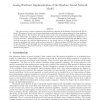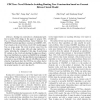305 search results - page 41 / 61 » On modeling top-down VLSI design |
FCCM
2007
IEEE
14 years 1 months ago
2007
IEEE
A new platform for reconfigurable computing has an object-based programming model, with architecture, silicon and tools designed to faithfully realize this model. The platform is ...
Publication
Within-die process variations arise during integrated circuit (IC) fabrication in the sub-100nm regime. These variations are of paramount concern as they deviate the performance of...
IJCNN
2000
IEEE
13 years 12 months ago
2000
IEEE
This paper presents a simple continuous analog hardware realization of the Random Neural Network (RNN) model. The proposed circuit uses the general principles resulting from the u...
VLSID
2002
IEEE
14 years 7 months ago
2002
IEEE
Verification is one of the most complex and expensive tasks in the current Systems-on-Chip (SOC) design process. Many existing approaches employ a bottom-up approach to pipeline v...
ASPDAC
2006
ACM
14 years 1 months ago
2006
ACM
Abstract— Routing tree construction is a fundamental problem in modern VLSI design. In this paper we propose CDCTree, an Obstacle-Avoiding Rectilinear Steiner Minimum Tree (OARSM...


